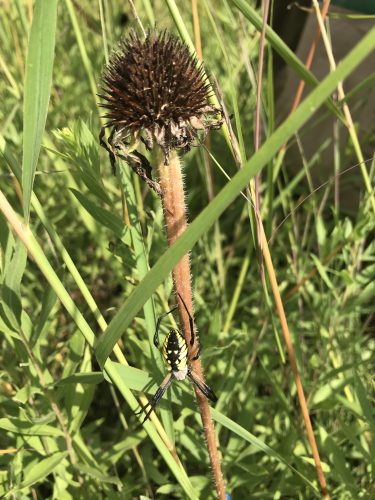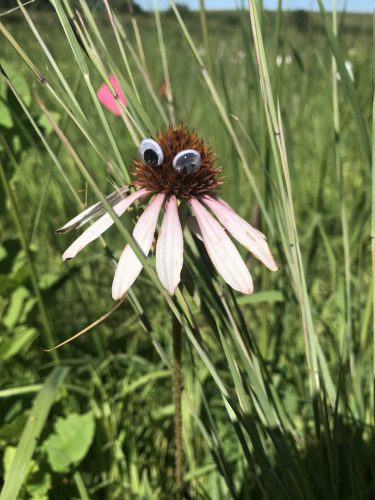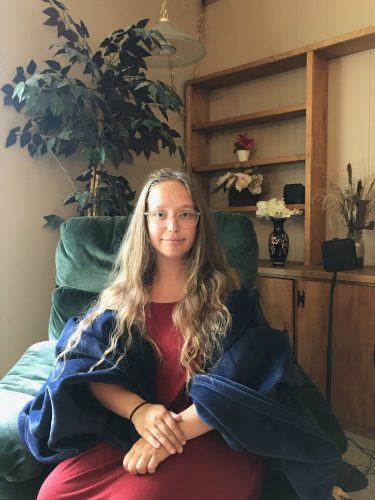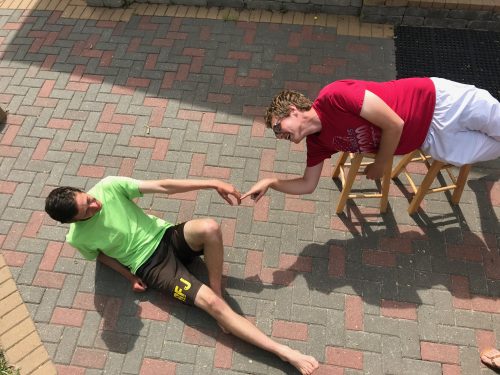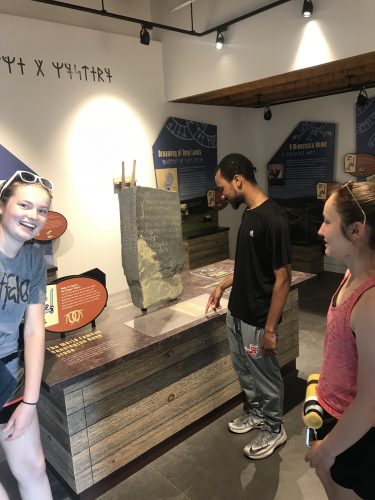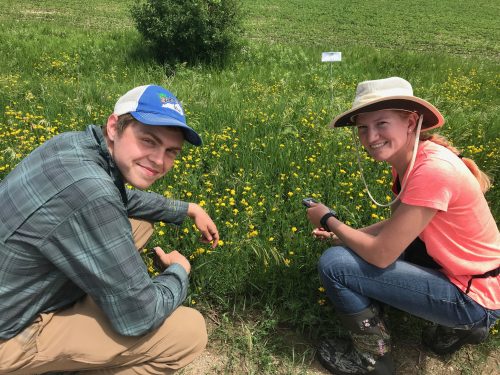|
|
 The aphids were a hit at Carleton’s Summer Research Symposium. At the Carleton College Summer Research Symposium on October 26th, I presented a poster on my work on the aphid addition/exclusion experiment. Over the summer, I administered the aphid addition and exclusion treatments for the experiment and collected data on leaf senescence and herbivory on plants in the study. Since August, I have been developing an aster model in R to analyze differences in fitness between these two experimental groups. Preparing the aster model for my project was quite a bit of work, but I learned more about R, statistical analysis, and plant-herbivore interactions in the process. Interestingly, Aphis echinaceae has not had an impact on plant fitness over the 8 years of the study.
I am excited to see how the experiment progresses in the coming years, and how the addition of data on seed set affects the results of future fitness models. Quite a few visitors to the symposium were also interested in the results of my analysis and my experience working with the aphids. It was a pleasure to represent the Echinacea Project at Carleton and to have a chance to share the fantastic work the team did over the summer.
This morning the much-diminished Team Echinacea (Stuart, Kristen, Lea, Michael, and I) gathered at the Hjelm house to start the day. Lea went to Staffenson Prairie Preserve to measure the flowering phenology of Liatris and Solidago plants. Michael and Kristen began to prepare experimental plot 8 for management in the coming year. The team will treat rogue Ashe trees and collect and broadcast the seeds of several prairie plant species in this plot. This is part of an ongoing effort to ensure that the plant community within the plot is consistent throughout.
Meanwhile, I assessed the leaf damage and senescence of plants in the aphid addition/exclusion experiment in p1. This was the final component of the fieldwork involved in this experiment for the season, and the last step in my independent project before I begin statistical analysis. The next step is to gauge fitness differences between plants in the aphid addition and exclusion treatments by constructing an aster model. While it was exciting to finish this aspect of the project, I will miss spending time with my Aphis echinaceae friends.
Over lunch the team prepared for inclement weather by sharing our experiences of intense weather events. After that, Kristen presented an update on her master’s project. She shared some intriguing preliminary results about the nesting preferences of native ground-nesting bees. We are all looking forward to the results of her study! Due to the rainy weather, the team was ready to call it a day after Kristen’s presentation. We held a short meeting to plan next week’s schedule and then headed home for the weekend.
Following the departure of Team CowBee, the rest of team Echinacea has had an eventful two days. On Wednesday morning Brigid, Riley, Michael, Kristen, and I moved into our new lodging at Andes Tower Ski Area. While the ski runs are not open in August, we get to enjoy a scenic view of the hill from our front door.
 A large spider in the section of p1 planted in 1999 The Hjelm house feels much less crowded without the Wooster contingent of the team, but there is still plenty left to do in the field season. Today, for instance, was the first full team harvest session. In groups of two we visited every single of the more 900 heads in p1. Of these, quite a few were already ready for to be harvested.
This Monday morning began with an unusual surprise. The team arrived at the Hjelm house to find numerous googly-eyes covering almost every conceivable surface. Upon recovering from this shock, the team assessed phenology in experimental plot 1. Many plants are finished flowering and we will likely only assess phenology a few more times this season. Following phenology, the team split up into task forces, with different members working on such diverse activities as staking bee tent trap locations, assessing the photosynthetic rate of Echinacea, excluding and adding aphids to plants in p1, and collecting more phenology data from from other Echinacea populations! The team reconvened for lunch, and in the afternoon went to a remnant Echinacea population for our first day of flowering plant demography. I had a chance to use Darwin, the team’s new GPS, for the first time!
 A new variety of aphid? In the evening, the Roost held its fifth weekly Journal Discussion Club. For our discussion this week, I chose “The Problem with Wilderness” by environmental historian William Cronon. This essay focuses on the historical development of wilderness preservation and its place in the American environmental movement. Our resulting discussion was rich, and even became heated at times. We’re looking forward to the paper Riley chose for next week on the life-history traits of non-native fishes.
Today the residents of the Roost awoke to a rainy morning in Alexandria. We started off the day with a trip to the grocery store to stock up for the week, followed by several hours of rest and relaxation at the house. Later we got in touch with our inner artists. With Kristen’s help we attempted to recreate some of our favorite paintings (see below). In the evening we enjoyed a delicious dinner of mac and cheese with a jalapeño cheddar cheeto crumble, courtesy of Mia.
 Mona Lisa – Leonardo da Vinci
 American Gothic – Grant Wood
 The Scream – Edvard Munch
 The Creation of Adam – Michelangelo
Following Zeke’s excellent dinner last night, we well-fed residents of the Roost, plus Kristen and Will, extensively discussed what movie we should watch. 30 minutes of heated debate resulted only in a suggestion to watch The Smurfs (2011). Given the failure of these deliberations, the crew decided to play frisbee instead. The Roost and its allies honed their frisbee skills with several rounds of “Michael in the Middle.” After this intensive exercise, the crew drove to Dairy Queen for some well-deserved ice cream and then watched fireworks from a hill in Lake Brophy County Park.
 Making friends with Alex locals at Dairy Queen The residents of the Roost enjoyed a relaxed Sunday morning, but by lunch time we were ready for more adventure. In an effort to engage in the cultural heritage of the area, we visited Runestone Park near Kensington. There we toured the new visitor center and went on a brief, mosquito-filled hike. We then returned to Alex for a lovely dinner prepared by Mia.
 Evan attempts a new translation of the Kensington Runestone All in all, the Roost crew had a great weekend. We relaxed following our first week at the Echinacea Project, continued exploring Alexandria, and most importantly, enjoyed some quality bonding time.
The year is 1300 CE. Steven, a viking explorer, has just landed on the shores of the land that would one day become Kensington, Minnesota. Steven and his crew pull their longship ashore on the banks of the vast Southern Canadian Sea, weary from their long journey. Although Steven would never see how dairy, corn, and soybeans would feed the world of his progeny, Steven saw in this landscape the potential for a land of vast prosperity. In the first few months, Steven lost most of his crew to a frog-borne parasite, now known exclusively for its adverse health effects in dogs. Steven learned the lay of this new land but often struggled. He was drawn back to his homeland after many years of documenting the landscape. Steven took with him a new appreciation for the beauty of discovery, and respect for new lands. Though most traces of Steven’s visit are lost, the Kensington runestone documents Steven’s journey into the unknown.
In the years following Steven’s journey, this majestic Southern Canadian Sea receded further to the north, eventually becoming what we know today as the boundary waters. As the soil dried, the sea floor served as a mineral-rich substrate for the colonization of new seeds. This new community of plants (dominated by grasses, forbs, and legumes) became the tallgrass prairies we know and love. Many people and animals have come to appreciate the prosperity of this verdant land. The spot on which Steven first stepped foot on North American shores is known today as Steven’s Approach.
Today, Steven’s Approach provides scientists associated with the Echinacea Project an opportunity to study how small plant populations persist in fragmented habitats. The site is comprised of two small remnant prairie patches located along Wolly Lake Road near Kensington, Minnesota. Most of the site is dominated by non-native plants. Invasive plants like these often make it difficult for native plants to compete for resources and space. This ecological consequence of small habitat sizes may impact the native plants at this site. Steven’s Approach only had one flowering Echinacea individual. What are the chances for reproduction and survival when your population is 1? This single plant is dependent upon pollinators for spreading its genetic material. How close is the nearest Echinacea individual? Will this individual plant at Steven’s Approach be able to spread its genes onto the next generation? This plant may struggle to survive and reproduce in the coming years.

Perhaps Steven existed, perhaps he did not; regardless, we hope that you were able to see the value of Steven’s journey. Discovery, growth, and a willingness to live with an open mind were key to his success. Our own growth this summer will be a lot like Steven’s. Like Steven, we will approach this new experience with a willingness to grow. We will learn more about ecology and evolution in fragmented habitats. We will take the knowledge we gain from this summer back with us to our own institutions in the fall. While we seek knowledge about the world around us, we will really come to know ourselves.
Echinacea Project 2018
History, Carleton College 2019
Research Interests
As a history major, I am interested in researching historical relationships with and understandings of the landscape. In addition to history, I am interested in ecology and conservation. I have taken several courses on ecology, evolution, and environmental studies at Carleton College. Last summer, with the Carleton Ecology Lab, I researched plant community composition in the Carleton Arboretum tallgrass prairie restorations in south Minnesota. This experience helped me hone my research interests and sparked my interests in tallgrass prairie ecology, plant population and community ecology, and habitat restoration. At the Echinacea project, I am excited to research continue learning about tallgrass prairie ecology, and I am specifically interested in prairie fragmentation and its effects on prairie plant communities and plant-pollinator interactions.
Statement
I was born and raised in Lexington, Kentucky and I have been attending Carleton College in Northfield, Minnesota for the last three years. Upon graduation from Carleton, I plan on pursuing a graduate degree in a conservation-related field. In my free time, I enjoy playing guitar and tennis, birding, hiking, and baking. I am excited to be a part of Team Echinacea this Summer!

|
|


